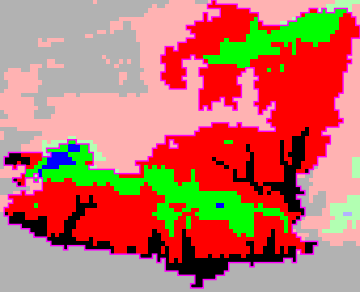What constrains wildfire burn areas?
Author
Assaad Mrad
Title
What constrains wildfire burn areas?
Description
A summer school project (2021) to identify the landscape features the limit wildfire spread
Category
Essays, Posts & Presentations
Keywords
California, Wildfires, Landscape, Open Street Maps
URL
http://www.notebookarchive.org/2021-07-61kkhb5/
DOI
https://notebookarchive.org/2021-07-61kkhb5
Date Added
2021-07-13
Date Last Modified
2021-07-13
File Size
18.7 megabytes
Supplements
Rights
Redistribution rights reserved

WOLFRAM SUMMER SCHOOL 2021
What constrains wildfire burn areas?
What constrains wildfire burn areas?
Introduction
Introduction
The goal of this 3-week project is to identify features of the landscape that tend to constrain burn areas once a wildfire starts. As western North America once again suffers a record-breaking drought, an intense fire season is thought to ensue in the second half of 2021. The only semi-effective response to such fire forecasts is to manage vegetated lands with high amounts of fuel - plant biomass. Managing fuels means reducing the fuel loading to create fire breaks, stripes of barren land to limit the spread of the fire, or pruning lower tree branches to reduce the probability of fire crowning. We aim to improve these managements strategies by identifying landscape features, natural or artificial, that are effective in limiting fire spread in the goal of emulating them.
The hypothesis of this project is that wildfire burn areas are constrained by different landscape elements such as fuel availability, natural fuel breaks such as water bodies and topography and artificial fuel breaks such as roads and forest clearing. The objectives are to 1) visualize different landscape layers simultaneously with burn areas for a high-level exploration of our hypothesis, 2) define quantitative metrics to relate landscape layers to burn areas, 3) and develop statistical and mechanistic modeling tools to describe burn area shape and distribution.
While the analysis in this project applies to wildfires anywhere on Earth, we decided to limit the geographic range to California due to relatively better data accessibility and because of the severe fire season that will follow this year.
The hypothesis of this project is that wildfire burn areas are constrained by different landscape elements such as fuel availability, natural fuel breaks such as water bodies and topography and artificial fuel breaks such as roads and forest clearing. The objectives are to 1) visualize different landscape layers simultaneously with burn areas for a high-level exploration of our hypothesis, 2) define quantitative metrics to relate landscape layers to burn areas, 3) and develop statistical and mechanistic modeling tools to describe burn area shape and distribution.
While the analysis in this project applies to wildfires anywhere on Earth, we decided to limit the geographic range to California due to relatively better data accessibility and because of the severe fire season that will follow this year.
Outline
Outline
1
.Data import, data wrangling, and function definitions
1
.1
.Burn perimeter data: data import and wrangling
1
.2
.Burn perimeter data: create California wildfires dataset
1
.3
.Vegetation Classification: data import and wrangling
1
.4
.Elevation: data import and wrangling
1
.5
.Function definitions for visualizing and describing the statistics of vegetation and elevation inside and around fires
1
.6
.Vector data: import roads and rivers overlying and surrounding wildfires
1
.7
.Function definitions for analyzing boundaries in vector form: roads and rivers
2
.Vector boundaries
3
.Raster data: vegetation classification
4
.Machine Learning methods: vegetation classification
5
.Machine Learning methods: vegetation and elevation combined
6
.Future work: testing the wind-driven vs fuel-driven fire paradigms
7
.Future work: weather data
An extensive resource for fire perimeters is the Monitoring Trends in Burn Severity (MTBS) website. On the website, one can download the raw data from the Burned Areas Boundaries Dataset . I downloaded the zip file and put it in the same folder as this notebook. This dataset contains the perimeters of all reported burns, including wildfires and prescribed fires, in the United States from 1984 to 2019. This data will be imported and wrangled in the “Import burn perimeter data: data wrangling” section. The perimeter data will then be subset to only include California wildfires and will be analyzed in “Import burn perimeter data: data analysis” section.
Data import, data wrangling, and function definitions
Data import, data wrangling, and function definitions
Burn perimeter data: data import and wrangling
Burn perimeter data: data import and wrangling
Burn perimeter data: create California wildfires dataset
Burn perimeter data: create California wildfires dataset
Vegetation Classification: data import and wrangling
Vegetation Classification: data import and wrangling
Elevation: data import and wrangling
Elevation: data import and wrangling
Function definitions for visualizing and describing the statistics of vegetation and elevation inside and around fires
Function definitions for visualizing and describing the statistics of vegetation and elevation inside and around fires
Vector data: import roads and rivers overlying and surrounding wildfires
Vector data: import roads and rivers overlying and surrounding wildfires
Load from .wxf file
Load from .wxf file
In[]:=
{roadMapsByType,roadPolyRas,boundaryByType,morphCompNum}=Import[NotebookDirectory[]<>"communityPostVector.wxf"];
Define thickness of each vector element in the “getRoadMap” function below
Define thickness of each vector element in the “getRoadMap” function below
In[]:=
thicknesses=<|"road_primary"->0.005,"road_primary_ramp"->0.005,"road_primary_bridge"->0.005,"road_motorway"->0.005,"road_motorway_ramp"->0.005,"road_motorway_bridge"->0.005,"road_secondary"->0.003,"road_secondary_ramp"->0.003,"road_secondary_bridge"->0.003,"road_tertiary"->0.002,"road_tertiary_ramp"->0.002,"road_tertiary_bridge"->0.002,"road_minor"->0.001,"road_trunk"->0.001,"waterway_river"->0.005,"waterway_canal"->0.005|>;
Function to return a rasterized map of roads and rivers overlying and surrounding fires
Function to return a rasterized map of roads and rivers overlying and surrounding fires
In[]:=
getRoadMap[proj_,bounds_,dims_,opts___]:=With[{map=GeoGraphics[opts,PlotRange->bounds,GeoProjectionproj,GeoBackground->"VectorMinimal",GeoZoomLevel12,BackgroundBlack]},Rasterize[map/.{Annotation[{style_,prim_},layer:{"line",lt_,_},type_]:>If[!KeyExistsQ[thicknesses,lt],Nothing,Annotation[{Directive[Antialiasing->False,White,Thickness[thicknesses[lt]]],prim},layer,type]],Annotation[{style_,prim_},layer_,type_]:>Nothing},RasterSize->dims,BackgroundBlack]]
Example for the RUSH fire of 2012:
In[]:=
getRoadMap["Mercator",GIS`RangeTransformation[getBoundingBox[dsCaPoly[2,"Geometry"]],proj->"Mercator"],{1000,1000}]
Out[]=
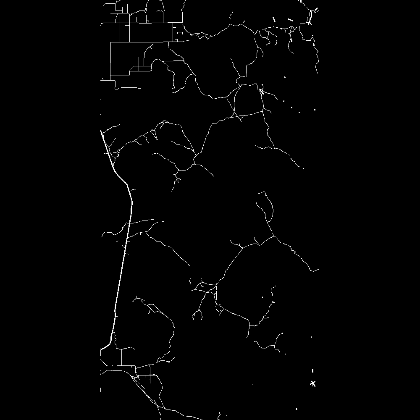
Function to return a rasterized map of either roads or rivers
Function to return a rasterized map of either roads or rivers
This function will be used to determine the most effective types of boundaries to wildfires
In[]:=
getRoadMapByType[proj_,bounds_,dims_,types_,opts___]:=With[{map=GeoGraphics[opts,PlotRange->bounds,GeoProjectionproj,GeoBackground->"VectorMinimal",GeoZoomLevel12,BackgroundBlack]},Rasterize[map/.{Annotation[{style_,prim_},layer:{"line",lt_,_},type_]:>If[!StringMatchQ[lt,types],Nothing,Annotation[{Directive[Antialiasing->False,White,Thickness[0.001]],prim},layer,type]],Annotation[{style_,prim_},layer_,type_]:>Nothing},RasterSize->dims,BackgroundBlack]]
getType is different from getRoadMapByType in that it is fed a map instead of computing it itself
In[]:=
getType[map_,dims_,types_]:=Rasterize[map/.{Annotation[{style_,prim_},layer:{"line",lt_,_},type_]:>If[!StringMatchQ[lt,types],Nothing,Annotation[{Directive[Antialiasing->False,White,Thickness[0.001]],prim},layer,type]],Annotation[{style_,prim_},layer_,type_]:>Nothing},RasterSize->dims,BackgroundBlack]
Example for the Happy Camp Complex of 2014 for roads:
In[]:=
getRoadMapByType["Mercator",GIS`RangeTransformation[getBoundingBox[dsCaPoly[16,"Geometry"]],proj->"Mercator"],{300,300},___~~"road"~~__]
Out[]=

Function to rasterize a polygon of a burn area to Highlight relevant vectors in (colored) road maps
Function to rasterize a polygon of a burn area to Highlight relevant vectors in (colored) road maps
In[]:=
roadRasterize[geom_]:=ColorConvert[Rasterize[Graphics[Style[Normal@geom,AntialiasingFalse],PlotRangegetBoundingBox[geom]],RasterSize{1000,1000}],"Grayscale"]
Compute roadMaps, roadMapsColored, and rasterized fire polygons for all California wildfires since 2001
Compute roadMaps, roadMapsColored, and rasterized fire polygons for all California wildfires since 2001
In[]:=
(*roadPolyRas=ResourceFunction["DynamicMap"][roadRasterize[dsCaPoly[#,"Geometry"]]&,Range[Length[dsCaPoly]]];*)
In[]:=
(*roadMapsByType2=Table[With[{map=GeoGraphics[PlotRange->GIS`RangeTransformation[getBoundingBox[dsCaPoly[i,"Geometry"]],proj->"Mercator"],GeoProjection"Mercator",GeoBackground->"VectorMinimal",GeoZoomLevel12,BackgroundBlack]},{getType[map,{300,300},___~~"road"~~__],getType[map,{300,300},___~~"waterway"~~__]}],{i,Range[201,400]}];*)
Save road
Save road
In[]:=
(*BinaryWrite[NotebookDirectory[]<>"roadMapsByType2.wxf",ExportByteArray[roadMapsByType2,"WXF"]];*)
In[]:=
(*Close[NotebookDirectory[]<>"roadMapsByType2.wxf"];*)
In[]:=
(*roadMaps=ResourceFunction["DynamicMap"][With[{bbEqui=GIS`RangeTransformation[getBoundingBox[dsCaPoly[#,"Geometry"]],proj->"Mercator"]},ColorConvert[getRoadMap["Mercator",bbEqui,{1000,1000}],"Grayscale"]]&,Range[Length[dsCa]]];*)
In[]:=
(*roadMapsColored=ResourceFunction["DynamicMap"][With[{bbEqui=GIS`RangeTransformation[getBoundingBox[dsCaPoly[#,"Geometry"]],proj->"Mercator"]},getRoadMapColored["Mercator",bbEqui,{300,300}]]&,Range[Length[dsCa]]];*)
Function definitions for analyzing boundaries in vector form: roads and rivers
Function definitions for analyzing boundaries in vector form: roads and rivers
Function to get fraction of boundaries bounded by each vector component using the roadMapsByType
Function to get fraction of boundaries bounded by each vector component using the roadMapsByType
In[]:=
boundaryTypes[fireRas_,map_]:=Module{imDia=Dilation[map,DiskMatrix[0.5]],fireRasResized=EdgeDetect[ImageResize[fireRas,{300,300}],1],boundaryLength,boundTypeCounts},boundaryLength=ImageMeasurements[fireRasResized,"Total"];boundTypeCounts=ImageMeasurements[Binarize[fireRasResized-ColorSeparate[imDia,"R"],0.5],"Total"];1-
boundTypeCounts
boundaryLength
Compute the boundary types for the largest 400 fires in California since 2000
In[]:=
(*boundaryByType=ResourceFunction["DynamicMap"][{boundaryTypes[roadPolyRas[[#]],roadMapsByType[[#,1]]],boundaryTypes[roadPolyRas[[#]],roadMapsByType[[#,2]]]}&,Range[400]];*)
Function to calculate the number of morphological components formed by roads or rivers
Function to calculate the number of morphological components formed by roads or rivers
In[]:=
getMorphCompNum[fireRas_,map_]:=Module[{morphComp=MorphologicalComponents[ImageSubtract[ColorNegate@ImageResize[fireRas,{300,300}],Dilation[map,DiskMatrix[2]]],0.9],selectComps},selectComps=Select[Tally[Flatten[morphComp]],#[[2]]>100&][[All,1]];Length[selectComps]-1]
Compute the number of morphological components for the largest 400 fires in California since 2000
In[]:=
(*morphCompNum=ResourceFunction["DynamicMap"][{getMorphCompNum[roadPolyRas[[#]],roadMapsByType[[#,1]]],getMorphCompNum[roadPolyRas[[#]],roadMapsByType[[#,2]]]}&,Range[400]];*)
Function to plot morphological components containing more than 100 pixels
Function to plot morphological components containing more than 100 pixels
In[]:=
plotMorphComp[fireRas_,map_]:=Module[{morphCompRanch=MorphologicalComponents[ImageSubtract[ColorNegate@ImageResize[fireRas,{300,300}],Dilation[map,DiskMatrix[2]]],0.9],selectComps},selectComps=Select[Tally[Flatten[morphCompRanch]],#[[2]]>100&][[All,1]];Colorize[morphCompRanch/.(x_Integer/;(!MemberQ[selectComps,x])->0),ImageSizeSmall]]
Example for the Ranch fire of 2012 for roads:
In[]:=
plotMorphComp[roadPolyRas[[1]],roadMapsByType[[1,1]]]
Out[]=

Save files necessary for vector analysis in community post
Save files necessary for vector analysis in community post
Vector boundaries
Vector boundaries
In[]:=
GeoGraphics{EdgeForm[Black],FaceForm[Red],Tooltip[#3,#1<>", "<>DateString@#2]&@@@Query[;;60,{"IncidName","IgDate","Geometry"}][dsCa]},GeoRange->
California, United States | ADMINISTRATIVE DIVISION |
Out[]=

Variable effectiveness of roads and rivers as barriers
Variable effectiveness of roads and rivers as barriers
The effectiveness of roads and rivers as barriers to wildfire spread varies from fire to fire. From some of the most intense fires in the presence of wind, the creation and transport of embers by wind can spread a fire across wide fire breaks like roads and rivers. In that case, what one sees is similar to the left panel of the figure below where the Ranch fire spreads across multiple roads, colored in magenta. An equivalent view of the same phenomenon is that these roads divide the fire raster, colored in black, into multiple disconnected components which we will expand upon below. Rivers are not primary features of that landscape as they are sparse and only border 6.1% of the fire in the case of the Ranch fire. From the vector map on the right panel, one can see that water bodies occasionally block fires.
The Ranch fire of 2018: the presence of roads does not guarantee containment
In[]:=
Grid[{{"",Style["Roads",18],Style["Rivers",18],Style["Map",18]},{Rotate[Style["Boundary %",18],π/2],Style[NumberForm[boundaryByType[[1,1]]*100,2],16],Style[NumberForm[boundaryByType[[1,2]]*100,2],16],""},{Rotate[Style["Maps and rasters",18],π/2],HighlightImage[ImageResize[roadPolyRas[[1]],{300,300}],Thinning[roadMapsByType[[1,1]]],ImageSize->Small,ImagePadding10],HighlightImage[ImageResize[roadPolyRas[[1]],{300,300}],{Blue,Thinning[roadMapsByType[[1,2]]]},ImageSize->Small,ImagePadding10],GeoGraphics[dsCa[1,"Geometry"],GeoBackground"VectorMinimal",GeoZoomLevel12,ImageSizeSmall]}}]
Out[]=
Roads | Rivers | Map | |
Boundary % | 41. | 6.1 | |
Maps and rasters | 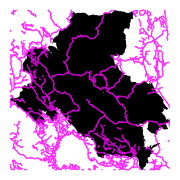 | 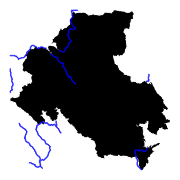 |  |
Roads are a more effective barrier in the case of the Happy Camp Complex according to the left panel in the figure below. This is due to roads only dividing the complex into 3 regions, indicating that the fire jumped across 2 roads at most only even though roads bordered 47% of the fire, more than the Ranch fire above. An important landscape feature around many fires is that roads and rivers are often co-located as seen by comparing the panels below. This might confound the analysis of the effectiveness of roads versus rivers as fire barriers.
The Happy Camp Complex of 2014: a case where roads and rivers are effective wildfire barriers
In[]:=
Grid[{(*{Style["The Happy Camp Complex of 2014: a case where roads and rivers are effective wildfire barriers",18],SpanFromLeft,SpanFromLeft},*){"",Style["Roads",18],Style["Rivers",18],Style["Map",18]},{Rotate[Style["Boundary %",18],π/2],Style[NumberForm[boundaryByType[[16,1]]*100,2],16],Style[NumberForm[boundaryByType[[16,2]]*100,2],16],""},{Rotate[Style["Maps and rasters",18],π/2],HighlightImage[ImageResize[roadPolyRas[[16]],{300,300}],Thinning[roadMapsByType[[16,1]]],ImageSize->Small,ImagePadding10],HighlightImage[ImageResize[roadPolyRas[[16]],{300,300}],{Blue,Thinning[roadMapsByType[[16,2]]]},ImageSize->Small,ImagePadding10],GeoGraphics[dsCa[16,"Geometry"],GeoBackground"VectorMinimal",GeoZoomLevel12,ImageSizeSmall]}}]
Out[]=
Roads | Rivers | Map | |
Boundary % | 47. | 31. | |
Maps and rasters |  |  |  |
We can use the idea of splitting fire rasters into morphological components based on road and river vectors to quantify their effectiveness. When fires jump more often across roads, they are split into more morphological components. Thus, a smaller number of components indicates a more effective barrier given a certain boundary percentage. The figure below shows the same two example fires above but split into morphological components based on road vectors. The Ranch fire has 14 morphological components compared to the Happy Camp Complex’s 3. This result quantifies the observation we made above that roads are a more effective barrier to fire spread in case of the latter. This statement is based also on the proportion of the fire boundaries being occupied by roads being similar, 41 and 47%.
Roads splitting fire rasters into multiple morphological components: a measure of effectiveness
In[]:=
Grid[{{"",Style["Ranch fire",18],Style["Happy Camp Complex",18]},{Rotate[Style["#",18],π/2],Style[morphCompNum[[1,1]],16],Style[morphCompNum[[16,1]],16]},{Rotate[Style["Morphological components",18],π/2],plotMorphComp[roadPolyRas[[1]],roadMapsByType[[1,1]]],plotMorphComp[roadPolyRas[[16]],roadMapsByType[[16,1]]]}}]
Out[]=
Ranch fire | Happy Camp Complex | |
# | 14 | 3 |
Morphological components |  |  |
In[]:=
Rasterize[Grid[{{plotMorphComp[roadPolyRas[[1]],roadMapsByType[[1,1]]],plotMorphComp[roadPolyRas[[16]],roadMapsByType[[16,1]]]}}]]
Out[]=

Statistics over the largest 400 fires in California since year 2000
Statistics over the largest 400 fires in California since year 2000
Raster data
Raster data
Explore dominant vegetation types inside and around fires
Explore dominant vegetation types inside and around fires
Compute dominant vegetation type inside and around the fire
Compute dominant vegetation type inside and around the fire
Import if already saved
Import if already saved
In[]:=
dominantVegClassAssociation=Association[Import[NotebookDirectory[]<>"burnVegClassAssociationType2.wxf"]/.{x_,y_}:>Association[x,y]];
Example for Ranch fire of 2012
In[]:=
dominantVegClassAssociation[[;;2]]
Out[]=
{39.269,-122.775,427048}inside{Evergreen Needleleaf Forests,0.387276},around{Woody Savannas,0.28502},{40.603,-120.09,306811}inside{Grasslands,0.999701},around{Grasslands,0.991457}
The Keys for this association are {lat, lon, acres}. These were was used in an earlier version of the notebook to create a classifier for predicting vegetation dominance based on them. But then I opted against them because the good results were probably artefacts of dominant vegetation being a function of topography, location, and elevation inherently.
Save burnVegClassAssociation as WXF file
Save burnVegClassAssociation as WXF file
Filter out cases where dominant vegetation is “unclassified”
Filter out cases where dominant vegetation is “unclassified”
In[]:=
dominantVegClassAssociationFiltered=Query[Select[StringQ[#inside[[1]]]&&StringQ[#around[[1]]]&&!StringMatchQ[#around[[1]],"Unclassified"]&]]@Association[dominantVegClassAssociation/.{x_,y_}:>Association[x,y]];
Vegetation bar plot inside and around burn areas
Vegetation bar plot inside and around burn areas
In[]:=
Grid[{{Style["Dominant vegetation types by number of wildfires",18],SpanFromLeft},Function[i,BarChart[KeySort@Counts@DeleteMissing@Query[Values,#[i][[1]]&][dominantVegClassAssociationFiltered],ChartLabelsPlaced[Automatic,{{0.5,0},{0.9,1}},Rotate[#,(2/7)Pi]&],FrameTrue,PlotLabeli,ImageSizeMedium]]/@{"inside","around"}}]
Out[]=
Dominant vegetation types by number of wildfires | |
 |  |
Dense Herbaceous vegetation class dominates both inside and around the forest, this is not surprising as this is the most abundant vegetation class in California. The second most abundant class is Evergreen Needleleaf Forests.
Vegetation bar plot inside and around burn areas when they are different
Vegetation bar plot inside and around burn areas when they are different
In[]:=
burnVegDiff=Query[Select[!StringMatchQ[#inside[[1]],#around[[1]]]&]][dominantVegClassAssociationFiltered];
In[]:=
Grid[{{Style["Dominant vegetation types when they are different inside and around each fire",18],SpanFromLeft},Function[i,BarChart[KeySort@Counts@DeleteMissing@Query[Values,#[i][[1]]&][burnVegDiff],ChartLabelsPlaced[Automatic,{{0.5,0},{0.9,1}},Rotate[#,(2/7)Pi]&],FrameTrue,PlotLabeli,ImageSizeMedium]]/@{"inside","around"}}]
Out[]=
Dominant vegetation types when they are different inside and around each fire | |
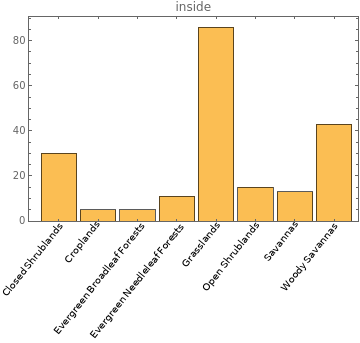 |  |
Even when the dominant vegetation types inside and around fires are different, the Grasslands type still is the most abundant in terms of the number of fires (inside area) it dominates. However, the dominant types around fires are Evergreen Broadleaf Forests, Savannas, and grasslands.
Create an array of vegetation probability within and around each fire
Create an array of vegetation probability within and around each fire
The idea here is to create an array of vegetation classes for each fire such that each element of the array is a percentage of all pixels inside the burn area. A background association “vegClassBackground” is created to get the same array size for each fire such that we will get a matrix in the end.
In[]:=
vegClassBackground=KeySort[Association[(#->0)&/@Values@vegClass]]
Out[]=
Closed Shrublands0,Cropland/Natural Vegetation Mosaics0,Croplands0,Deciduous Broadleaf Forests0,Evergreen Broadleaf Forests0,Evergreen Needleleaf Forests0,Grasslands0,Mixed Forests0,Non-Vegetated Lands0,Open Shrublands0,Permanent Wetlands0,Savannas0,Unclassified0,Urban and Built-up Lands0,Water Bodies0,Woody Savannas0
In[]:=
(*vegMatrixInside=With[{temp=KeySort[Merge[{getVegList[vegClass,burnAreaVegClass[Lookup[#,"Geometry"],targetRange,lcImageProj[Lookup[#,"IgDate"]["Year"]],10],"inside"],vegClassBackground},Total]]},Values[N[temp/Total[temp]]]]&/@Normal@dsCaPoly;*)
In[]:=
(*vegMatrixAround=With[{temp=KeySort[Merge[{getVegList[vegClass,burnAreaVegClass[Lookup[#,"Geometry"],targetRange,lcImageProj[Lookup[#,"IgDate"]["Year"]],10],"around"],vegClassBackground},Total]]},Values[N[temp/Total[temp]]]]&/@Normal@dsCaPoly;*)
In[]:=
{vegMatrixInside,vegMatrixAround}=Import[NotebookDirectory[]<>"vegMatricesType2.wxf"];
In case matrices were just computed, save as WXF file
In case matrices were just computed, save as WXF file
Machine Learning methods: vegetation classification
Machine Learning methods: vegetation classification
The goal is to create a classifier to predict whether a given vegetation list is inside or around a fire. For the first try, only have vegetation data plugged in in the form of a matrix according to vegMatrixInside and vegMatrixOutside
Remove any arrays that have any “unclassified” pixels and drop any element because array elements sum to 1 without loss of information
Remove any arrays that have any “unclassified” pixels and drop any element because array elements sum to 1 without loss of information
In[]:=
unclassifiedPos=First@First@Position[Keys[vegClassBackground],"Unclassified"]
Out[]=
13
In[]:=
vegMatrixInsideReduced=Drop[Select[vegMatrixInside,#[[unclassifiedPos]]==0&],None,{1}];
In[]:=
vegMatrixAroundReduced=Drop[Select[vegMatrixAround,#[[unclassifiedPos]]==0&],None,{1}];
Join matrices by threading a Rule between each array and “inside” or “around”
Join matrices by threading a Rule between each array and “inside” or “around”
In[]:=
vegMatrixAll=Join[Thread[vegMatrixInsideReduced->"inside"],Thread[vegMatrixAroundReduced->"around"]];
Do a 70-30 split for training and validation
Do a 70-30 split for training and validation
In[]:=
testVegMat=RandomSample[vegMatrixAll,Round[Length[vegMatrixAll]*0.3]];trainingVegMat=Complement[vegMatrixAll,testVegMat];
Train a classifier
Train a classifier
In[]:=
insideOrAround=Classify[trainingVegMat,PerformanceGoal"Quality",ValidationSettestVegMat]
Out[]=
ClassifierFunction
|
Evaluate performance
Evaluate performance
In[]:=
Information[insideOrAround]
Out[]=
Classifier information | ||||||||||||||||||||||
| ||||||||||||||||||||||
From the information above, the accuracy of the classifier was ~63% which is a bit higher than the baseline accuracy of 50%. The baseline accuracy is 50% because the dataset is balanced which means that there are as many arrays for inside and for around the fire.
In[]:=
ClassifierMeasurements[insideOrAround,testVegMat,"AreaUnderROCCurve"]
Out[]=
around0.691774,inside0.693697
The Area under the ROC is about 70% which is not bad but not too good.
In[]:=
ClassifierMeasurements[insideOrAround,testVegMat,"ConfusionMatrixPlot"]
Out[]=

A large number is misclassified.
Future work: Do a scalewise variation. Pick incrementally larger study areas. (Tirtha) Split vegetation into coastal and inland to evaluate fuel-driven vs wind-driven fires. Drop fires that have water bodies and barren lands around them to see if classifier still gets 63% accuracy. We suspect the relatively high accuracy might be an artefact of that.
Trying an an unsupervised method, DimensionReduce, to see if there is a clear split
Trying an an unsupervised method, DimensionReduce, to see if there is a clear split
In[]:=
features=DimensionReduce[Join[vegMatrixInsideReduced,vegMatrixAroundReduced],Method->"TSNE"];
In[]:=
ListPlot[With[{len=features//Length},{features[[;;Round[len/2]]],features[[Round[len/2]+1;;]]}]]
Out[]=
There is no clear split but Stephen thinks there might be something behind this structure and that it is worth studying more deeply.
Machine Learning methods: vegetation and elevation combined
Machine Learning methods: vegetation and elevation combined
Visualization and computation
Visualization and computation
Visualize elevation raster for the WOOLSEY fire of 2018
Visualize elevation raster for the WOOLSEY fire of 2018
In[]:=
viz[burnAreaRasIm[dsCaPoly[21,"Geometry"],targetRange,elevImProj]]
Out[]=
| ||||||||
| ||||||||
Compute mean and std of elevation and slope of each fire
Compute mean and std of elevation and slope of each fire
In case meanElevList was just computed, save as WXF file
In case meanElevList was just computed, save as WXF file
Elevation statistics for California wildfires
Elevation statistics for California wildfires
In[]:=
Histogram[meanStdElevAroundList[[All,1]],FrameTrue,FrameLabel{{"Mean fire elevation",None},{"Fire frequency","Histogram of mean fire elevations"}}]
Out[]=

Classifier to predict whether a given vegetation list is inside or around a fire including mean fire elevation data as well as vegetation
Classifier to predict whether a given vegetation list is inside or around a fire including mean fire elevation data as well as vegetation
Define whitening transformation
Define whitening transformation
This is to drop the infinite precision assumption and make computations faster.
In[]:=
whiteningTransformation[list_]:=With{listFast=list*1.0},Transpose@;
Transpose@listFast-Mean[listFast]
StandardDeviation[listFast]
Remove any arrays that have any “unclassified” pixels and drop any element because array elements sum to 1 without loss of information
Remove any arrays that have any “unclassified” pixels and drop any element because array elements sum to 1 without loss of information
In[]:=
vegElevMatrixInside=Drop[Select[Join[vegMatrixInside,Partition[whiteningTransformation[meanStdElevList[[All,1]]],1],2],#[[unclassifiedPos]]==0&],None,{1}];
In[]:=
vegElevMatrixAround=Drop[Select[Join[vegMatrixAround,Partition[whiteningTransformation[meanStdElevAroundList[[All,1]]],1],2],#[[unclassifiedPos]]==0&],None,{1}];
Combine matrices and thread rules
Combine matrices and thread rules
In[]:=
vegElevMatrixAll=Join[Thread[vegElevMatrixInside->"inside"],Thread[vegElevMatrixAround->"around"]];
Split into training and validation 70-30
Split into training and validation 70-30
In[]:=
testVegElevMat=RandomSample[vegElevMatrixAll,Round[Length[vegElevMatrixAll]*0.3]];trainingVegElevMat=Complement[vegElevMatrixAll,testVegElevMat];
Train classifier
Train classifier
In[]:=
insideOrAroundElev=Classify[trainingVegElevMat,PerformanceGoal"Quality",ValidationSettestVegElevMat]
Out[]=
ClassifierFunction
|
In[]:=
Information[insideOrAroundElev]
Out[]=
Classifier information | ||||||||||||||||||||||
| ||||||||||||||||||||||
Accuracy has improved by 4%
In[]:=
ClassifierMeasurements[insideOrAroundElev,testVegElevMat,"AreaUnderROCCurve"]
Out[]=
around0.738152,inside0.738333
AUC has increased by 5%
In[]:=
ClassifierMeasurements[insideOrAroundElev,testVegElevMat,"ConfusionMatrixPlot"]
Out[]=

Classifier that includes mean fire slope
Classifier that includes mean fire slope
Compute matrices with the same dropping of “unclassified” cases
Compute matrices with the same dropping of “unclassified” cases
In[]:=
vegSlopeMatrixInside=Drop[Select[Join[vegMatrixInside,Partition[whiteningTransformation[meanStdSlopeList[[All,1]]],1],2],#[[unclassifiedPos]]==0&],None,{1}];
In[]:=
vegSlopeMatrixAround=Drop[Select[Join[vegMatrixAround,Partition[whiteningTransformation[meanStdSlopeList[[All,1]]],1],2],#[[unclassifiedPos]]==0&],None,{1}];
Combine matrices
Combine matrices
In[]:=
vegSlopeMatrixAll=Join[Thread[vegSlopeMatrixInside->"inside"],Thread[vegSlopeMatrixAround->"around"]];
Training and testing data
Training and testing data
In[]:=
testVegSlopeMat=RandomSample[vegSlopeMatrixAll,Round[Length[vegSlopeMatrixAll]*0.3]];trainingVegSlopeMat=Complement[vegSlopeMatrixAll,testVegSlopeMat];
Train classifier
Train classifier
In[]:=
insideOrAroundSlope=Classify[trainingVegSlopeMat,PerformanceGoal"Quality",Method"GradientBoostedTrees"]
Out[]=
ClassifierFunction
|
Classifier information
Classifier information
In[]:=
Information[insideOrAroundSlope]
Out[]=
Classifier information | ||||||||||||||||||||||
| ||||||||||||||||||||||
In[]:=
ClassifierMeasurements[insideOrAroundSlope,testVegSlopeMat,"AreaUnderROCCurve"]
Out[]=
around0.730713,inside0.730773
Classifier with mean elevation seems to fare better when it comes to AUC.
In[]:=
ClassifierMeasurements[insideOrAroundSlope,testVegSlopeMat,"ConfusionMatrixPlot"]
Out[]=

Future work: Include only slopes around the fire and differentiate whether they are going into or out of the fires.
Future work: testing the wind-driven vs fuel-driven fire paradigms
Future work: testing the wind-driven vs fuel-driven fire paradigms
Recently, California fires were categorized as either wind-driven or fuel driven (Keeley & Syphard, 2019). Typically in the mid- and north-western parts of the state, fuel-driven fires occur in regions where fire suppression and silvicultural practices have led to the accumulation of fuels where, historically, many fires occurred. Fuel-driven fires are usually caused by lightning and occur in the summer months (July & August). In contrast, wind-driven fires occur on the eastern part of the state. In the autumn, a high pressure system in the interior basin and a low pressure system over the Pacific means that high-speed offshore winds develop. These winds tend to intensify small fires, typically caused by humans, to form large conflagrations.
Examples of fuel driven fires are the Rush (2012), Rim (2013), Rough (2015), and Marble Cone (2007) fires
Examples of wind-driven fires are the Thomas (2017), Witch (2007), Camp (2018) fires
Future work: weather data
Future work: weather data
Use WeatherData. DayMet by ORNL. Daily meteorological values at surface based on observations. Temp (min and max; better for heat stress; deviation from climatic average; pentads: multiples of 5 days), Rainfall (last time, and cumulative).
Lauren: LandSurface index gives an idea of vegetation stress probability for my vegetation to burn. What type of soil do you have? If you have a lot of organic matter, then it plays a big role. SOM (Soil Organic Matter). if SOM % datasets don’t exist a lot, knowing soil porosity would be a good substitute.
->
Morphological components and see how many regions are covered to see how many roads the fire
Weather radar and precipitation.
In[]:=
dsCa[1,{"BurnBndLat","BurnBndLon","IgDate"}]
Out[]=
|
In[]:=
Normal@Values@dsCa[1,{"BurnBndLat","BurnBndLon"}]
Out[]=
{39.269,-122.775}
In[]:=
dsCa[5,"IgDate"]+
Out[]=
Mon 19 Aug 2013
AirTemperatureDataToExpression@Normal@Values@dsCa[5,{"BurnBndLat","BurnBndLon"}],dsCa[5,"IgDate"],dsCa[5,"IgDate"]+
1
days
Out[]=
TimeSeries
| ||||||
DateListPlot[%]
Out[]=
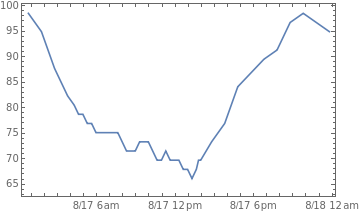
In[]:=
AirTemperatureDataToExpression@Normal@Values@dsCa[5,{"BurnBndLat","BurnBndLon"}],dsCa[5,"IgDate"]-,dsCa[5,"IgDate"]+,"Day"
5
days
5
days
Out[]=
TimeSeries
| ||||||
In[]:=
DateListPlot[%]
Out[]=
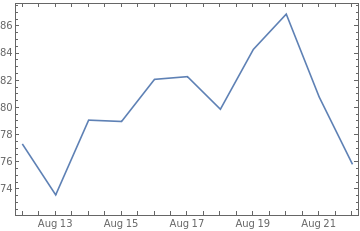
In[]:=
WindSpeedDataToExpression@Normal@Values@dsCa[5,{"BurnBndLat","BurnBndLon"}],dsCa[5,"IgDate"]-,dsCa[5,"IgDate"]+,"Day"
5
days
5
days
Out[]=
TimeSeries
| ||||||
In[]:=
DateListPlot[%]
Out[]=

WindSpeedDataToExpression@Normal@Values@dsCa[5,{"BurnBndLat","BurnBndLon"}],dsCa[5,"IgDate"]-,dsCa[5,"IgDate"]+,"Day"
5
days
5
days
In[]:=
WeatherData[ToExpression@Normal@Values@dsCa[2,{"BurnBndLat","BurnBndLon"}],"Temperature",dsCa[2,"IgDate"],TimeZone->"America/Los_Angeles"]
Out[]=
TimeSeries
| ||||||
In[]:=
DateListPlot[%]
Out[]=

In[]:=
$TimeZone
Out[]=
-4.
In[]:=
WeatherData["Chicago","Temperature",Yesterday]
Out[]=
TimeSeries
| ||||||
In[]:=
DateListPlot[%]
Out[]=

Cite this as: Assaad Mrad, "What constrains wildfire burn areas?" from the Notebook Archive (2021), https://notebookarchive.org/2021-07-61kkhb5
Download


